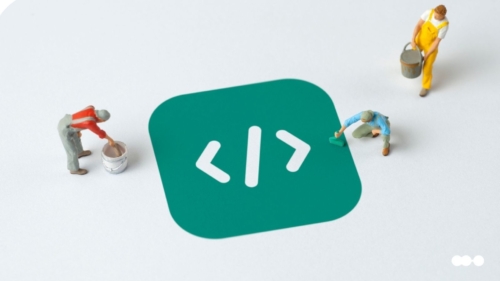
According to one estimate, 30% of work activities for over half of the jobs in the US could be automated. That’s a day and a half worth of hours each week that most workers could get back if their processes, workflows, and tasks didn’t require as much hands-on attention.
Of course, it’s one thing to recognize the value of automation for business workflows, and another to make it happen. The work of planning and implementing automations doesn’t have to be complicated and it shouldn’t be mysterious: it is just a matter of knowing what you want to do, recognizing what you can do, and then figuring out which tools you need to put it in motion.
That’s what this post is all about. This eight-point framework will guide you through the steps you need to take in order to automate any manual process or workflow.
See what it takes to build the perfect process

Step 1: Define your goal(s)
The first step toward automating a manual process is to define your goal(s) and understand your objectives. This will help you set your priorities and create an automation strategy that makes sense for your particular situation.
A common assumption about business process automation (BPA) is that the goal is always efficiency, but that’s not the case. The primary driver behind automation can also be:
- Adding value to the product or service
- Making processes more predictable or accurate
- Improving the customer experience
- Creating better outcomes for internal or external process customers
- Making work less repetitive or frustrating through human-centered automation
Regardless of why you want to automate your process, being able to define your goals can help you prioritize the workflows and task automation that need attention first.
| Goal | Common issue(s) |
|---|---|
| Deliver better customer experiences | Process is error prone, inconsistent, or slow. Customers lack status visibility. |
| Improve employee experience | Process includes too many repetitive tasks or takes up too much employee time. |
| Increase efficiency | Process is too expensive, takes too long to complete, and will not scale. |
Step 2: Identify the target process
Any business process can get complicated. Often what we refer to as “a process” may actually be a family of related processes or subprocesses. For example, a typical procurement process may include subprocesses such as approving vendors, creating purchase orders, receiving goods, and paying invoices.
Here’s an example of a relatively straightforward end-to-end sales process. This process is organized, clearly mapped, and each phase or decision point is noted. The starting point (new qualified lead) and the outcome (deal won) are clearly defined. This is an ideal starting point for automating a manual process.
Sales Pipeline

Step 3: Establish process boundaries
This step reinforces Step 2. Once you’ve identified the process you want to automate, you need to set the boundaries of the process just to make sure you stay focused. The easiest way to set the boundaries and avoid scope creep is to identify the trigger or starting point of the workflow or process you want to automate, and then identify the result or outcome.
Any manual tasks or activities that occur between these two points is a candidate for automation.

Step 4: Map your process
You’ve identified your starting point and stopping point. Now you need to create a process map or diagram that illustrates all the actors, actions, and information in the process workflow. You may create an informal map, or you may prefer to use standard flowchart symbols.
Depending on the complexity of your process, mapping might require the help of others on your team. That’s because you need to have the most complete map possible, which means including every task and every actor in the process workflow. Some of that information may have to come from team members who have their hands on the work.
| Element | Description |
|---|---|
| Actors | People who handle, hold, approve, or move the work at any point in the process |
| Tasks | Specific steps that must be completed in the process |
| Systems | Databases or applications that hold or impact the work |
| Information | Forms, documents, files, and other types of data |
Step 5: Identify the tasks that can be automated
The process map will provide you with an inventory of all the tasks and workflows that make up the process. The next step is to review each and decide if it’s a candidate for automation.
Keep in mind: Some tasks cannot be automated: they require human input and oversight every time they are completed. Other tasks don’t require the human touch and can be completed by a machine or software. To get you started, these are some common tell-tale qualities of tasks that can be automated:
| Quality | Description |
|---|---|
| Repetitive | Involves the same steps or inputs each time |
| Frequent | High volume task that must be completed multiple times in an hour, day, or week |
| Recurring | Tasks must be completed according to a regular schedule |
| Dependent | Triggered by another event or change in status |
| Simple | Does not require complex information, decision making, or problem solving |
| Predictable | Planned element of a workflow or process, occurs in every instance of the process |
| Collaborative | Requires action or input from multiple stakeholders |
Step 6: Create your automation wishlist
Some of the most common tasks that are automated include composing and sending emails, notifying team members, creating requests, or updating task statuses. Depending on your process and the tools you use, the automation possibilities are endless.
Step 7: Assess your capabilities
In order to make automations a reality, you’ll need the right automation tools. Software can make automation easy to implement and manage, for both simple and complex processes.
For most teams, low-code automation software provide the fastest path to automation. These types of tools make it much easier to implement new automations and refine existing ones. No-code and low-code tools don’t require as much time or effort from developers or IT teams, and they are frequently found in the citizen developer toolbox (this makes it possible to create citizen automation).
Step 8: Configure your automation
Now that you’ve set your process boundaries, identified the tasks and manual processes you want to automate, and reviewed your current software capabilities, it’s time to bring your automations to life.
Your workflow automation software should make it easy for you to plan and configure automations in any of your workflows. It’s simply a matter of deciding what will trigger the automation and what the automation will do.
Automate any process with just a few clicks
More about automation
Our articles hub is full of information about automating tasks, workflows, and digital processes. Find more resources on related topics including workflow automation , benefits of automation of processes and pros and cons of automation.






